| Data & Tools | Publications | Training |
What is it?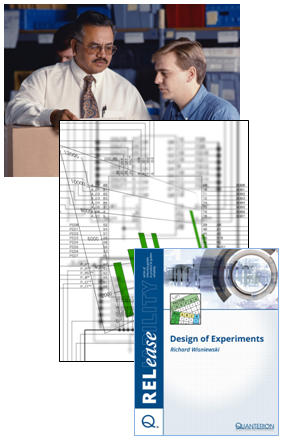
Design Of Experiments is a technically- and cost-efficient statistical methodology for assessing the effects of experimental factors on response variables of interest. If effectively used, the effects of many variables on a complex system can be examined simultaneously.
What’s the payoff?
Experimentation using DOE approaches is much more cost-effective than exhaustive testing of all system variables one-by-one, or implementing process and design changes without prior knowledge of the potential impacts. Identification/mitigation of design/process failure modes/mechanisms facilitates reliability growth.
How can we help?
- Evaluate your processes to determine where DOE may be most beneficial
- Implement a DOE plan to solve a specific design- or process-related problem
- Develop models that affect the variable relationships of your processes
- Train your staff in the effective use of DOE
Related Data & Tools:
 QuART PROThe QuART software series represents the fourth generation of the highly popular "Reliability Toolkit" series of RMQ engineering aids originated in 1988 by Quanterion personnel while working at the Rome Laboratory (formerly Rome Air Development Center).
QuART PROThe QuART software series represents the fourth generation of the highly popular "Reliability Toolkit" series of RMQ engineering aids originated in 1988 by Quanterion personnel while working at the Rome Laboratory (formerly Rome Air Development Center). QuART ER (Enhancing Reliability)This 2011 release features over 2 dozen new or improved tools over QuART PRO. QuART ER updates more than 10 tools and adds more than 15 new tools to the tool set available in QuART PRO, including the "Ask a Quanterion Expert" function that allows users to direct their reliability questions to an ASQ certified reliability expert at Quanterion.
QuART ER (Enhancing Reliability)This 2011 release features over 2 dozen new or improved tools over QuART PRO. QuART ER updates more than 10 tools and adds more than 15 new tools to the tool set available in QuART PRO, including the "Ask a Quanterion Expert" function that allows users to direct their reliability questions to an ASQ certified reliability expert at Quanterion.
Related Publications:
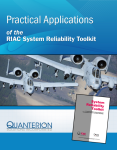 Practical Applications of the RIAC System Reliability ToolkitThe purpose of this publication is to provide illustrative examples of the more common mathematical calculations and statistical techniques utilized by reliability engineers in the practical performance of their daily activities. It is intended to be used as a companion to the RIAC “System Reliability Toolkit”, as the foundations of all of the techniques illustrated in this publication are discussed therein.
Practical Applications of the RIAC System Reliability ToolkitThe purpose of this publication is to provide illustrative examples of the more common mathematical calculations and statistical techniques utilized by reliability engineers in the practical performance of their daily activities. It is intended to be used as a companion to the RIAC “System Reliability Toolkit”, as the foundations of all of the techniques illustrated in this publication are discussed therein.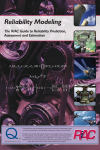 Reliability Modeling – The RIAC Guide to Reliability Prediction, Assessment and EstimationThe intent of this book is to provide guidance on modeling techniques that can be used to quantify the reliability of a product or system. In this context, reliability modeling is the process of constructing a mathematical model that is used to estimate the reliability characteristics of a product.
Reliability Modeling – The RIAC Guide to Reliability Prediction, Assessment and EstimationThe intent of this book is to provide guidance on modeling techniques that can be used to quantify the reliability of a product or system. In this context, reliability modeling is the process of constructing a mathematical model that is used to estimate the reliability characteristics of a product.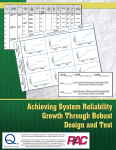 Achieving System Reliability Growth Through Robust Design and TestThis book offers new definitions of how failures can be characterized, and how those new definitions can be used to develop metrics that will quantify how effective a Design for Reliability (DFR) process is in (1) identifying failure modes and (2) mitigating their root failure causes.
Achieving System Reliability Growth Through Robust Design and TestThis book offers new definitions of how failures can be characterized, and how those new definitions can be used to develop metrics that will quantify how effective a Design for Reliability (DFR) process is in (1) identifying failure modes and (2) mitigating their root failure causes.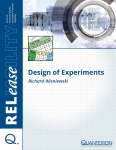 Design of ExperimentsExperiments are designed and executed in order to illuminate our understanding about a product or process. Characteristics of products and processes are frequently affected by various factors. In an experiment, one or more process variables (or factors) are changed in order to observe the effect the changes have on one or more response variables. Classical experiments focus on varying one factor at a time (0FAT or 1FAT), perhaps at one or two levels, and attempt to hold everything else constant.
Design of ExperimentsExperiments are designed and executed in order to illuminate our understanding about a product or process. Characteristics of products and processes are frequently affected by various factors. In an experiment, one or more process variables (or factors) are changed in order to observe the effect the changes have on one or more response variables. Classical experiments focus on varying one factor at a time (0FAT or 1FAT), perhaps at one or two levels, and attempt to hold everything else constant.
 Lunchtime Learning SeriesThe “Lunchtime Learning” series is a group of short course tutorials are aimed at providing a basic introduction to a variety of topics in which our community members have expressed an interest.
Lunchtime Learning SeriesThe “Lunchtime Learning” series is a group of short course tutorials are aimed at providing a basic introduction to a variety of topics in which our community members have expressed an interest. Design of Experiments for Reliability ImprovementMany times we want to improve Reliability (or other Quality characteristics) by way of increasing positive and reducing negative factor effects that influence performance.
Design of Experiments for Reliability ImprovementMany times we want to improve Reliability (or other Quality characteristics) by way of increasing positive and reducing negative factor effects that influence performance.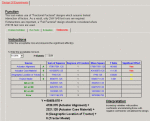 Which Variables Are Critical to Field Reliability? Design of Experiments (DOE) Can Help Optimize Your DesignEngineers are often faced with the problem of optimizing a process that includes a number of input variables. It could be an analysis of a manufacturing process, or even an analysis of a business process. They’re often challenged to find ways to reduce
Which Variables Are Critical to Field Reliability? Design of Experiments (DOE) Can Help Optimize Your DesignEngineers are often faced with the problem of optimizing a process that includes a number of input variables. It could be an analysis of a manufacturing process, or even an analysis of a business process. They’re often challenged to find ways to reduce

